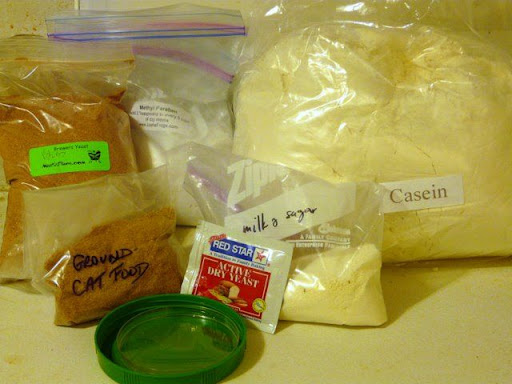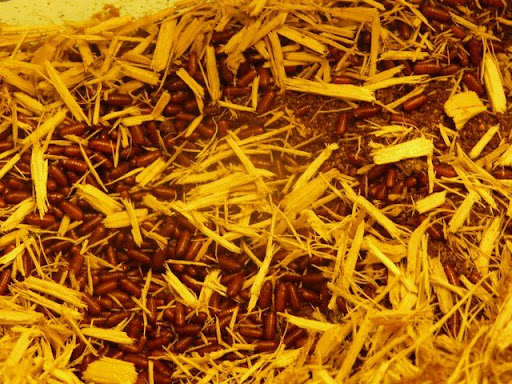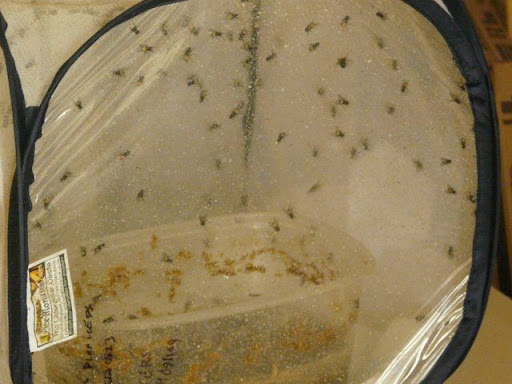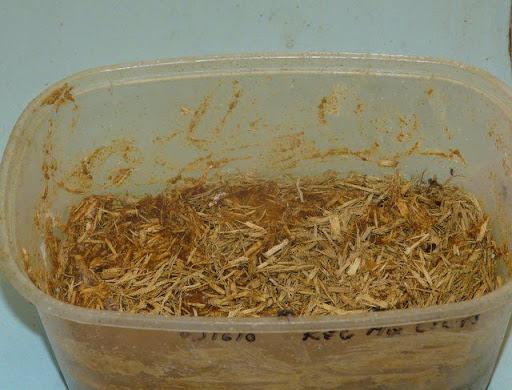PhilinYuma
Well-known member
At the beginning of this month I put a rectangular clearplastic container with three cups of housefly breeding medium in a 12"net cubewith 10G of housefly pupae in an inverted lid.. The medium consisted of onepart cat food steeped in two parts simmering water and rendered into mud with afood processor. I also added wood chips( ) in sufficient quantity that theycould be seen throughout the mixture but not enough to form clumps. I didn't add anything else except for a smallquantity of active baker's yeast on the top.
Winter is still with us in Yuma and the temp was about 75F at night and80ish during the day so this slowed down development time compared with summer.
There are several advantages to this method over using a 32oz cup as a breeding enclosure. The mostimportant is that the danger of an anaerobic (oxygen free) environment is muchless likely to occur than in a pot where oxygen intake can be blocked by afouled lid. . Another problem is that when the adults eclose (emerge), severalhundred flies greatly overcrowd a 32oz pot, and it is hard to feed them.
The procedure is easy. Remove the container when it is fullof maggots, transfer it to another cube and leave the pupae, which will formeventually, in the pot to eclose.
If you have set up the right amount of food – about 3 cupsfor 250 flies (5G pupae) you do not need to add water, which will force themaggots out or put wood chips on top for the pupae, which will block access tooxygen (I learned the hard way!).
After about three weeks, I now have 2,053 flies and they arestill eclosing. This is not too impressive when you remember that I used 500flies – approximately 250 females – and each female can lay up to 300 eggs.These things breed like, well, flies! I keep the flies in the cube and feedthem a sugar/powdered mil mix in an inverted lid. I also smear honey on the topof the netting and mist the cube two to three times daily. Fouled cubes can besoaked in 10% bleach solution (one part of commercial bleach in nine partswater)
I now consider this method a success. The flies wereproduced with little effort and, aside from one error, the medium is virtuallyodor free and never unpleasant.
After doing the post on fly larva nutrition and hearing ofHibiscusmile's success with adding brewers yeast and casein (milk protein), Iset up two pots in an enclosure with 500 flies. One contained three cups of theregular mix as used before, the second contained two cups of the mix and half acup each of the brewer's yeast and casein.
I started on 031610 and removed them both today. Alreadythere is a visible difference. The medium has been turned over by the maggotsin both pots and a lot of the wood shavings brought to the surface, though theyare not blocking out air. Immediately under this layer in the "regular" pot isa layer of large maggots with smaller ones lower down. In the second pot, thereis a layer of smaller larvae below, but on top, pupae waiting to eclose, somealready quite dark (nearly ready to emerge). This means that either the maggotsgrow faster in the protein enriched medium, or the flies laid in it first. Fromthe similar numbers, though, the former is more likely the case.
As soon as the two pots give up flies, I shall give you acount to see if the enriched medium gives a better enough yield to justify theextra cost. The micellar casein that I used (for body builders ) costs about$6/pound, but you have to buy six pounds. The brewer's yeast, generously givento me by Rebecca, costs about $5/pound. I have used a variety of dog/cat foods.
) costs about$6/pound, but you have to buy six pounds. The brewer's yeast, generously givento me by Rebecca, costs about $5/pound. I have used a variety of dog/cat foods.
Edit: I wrote this as a Word doc and pasted it here. Unaccountably, a lot of words ran together and I am afraid that I am too lazy to separate them all!
Winter is still with us in Yuma and the temp was about 75F at night and80ish during the day so this slowed down development time compared with summer.
There are several advantages to this method over using a 32oz cup as a breeding enclosure. The mostimportant is that the danger of an anaerobic (oxygen free) environment is muchless likely to occur than in a pot where oxygen intake can be blocked by afouled lid. . Another problem is that when the adults eclose (emerge), severalhundred flies greatly overcrowd a 32oz pot, and it is hard to feed them.
The procedure is easy. Remove the container when it is fullof maggots, transfer it to another cube and leave the pupae, which will formeventually, in the pot to eclose.
If you have set up the right amount of food – about 3 cupsfor 250 flies (5G pupae) you do not need to add water, which will force themaggots out or put wood chips on top for the pupae, which will block access tooxygen (I learned the hard way!).
After about three weeks, I now have 2,053 flies and they arestill eclosing. This is not too impressive when you remember that I used 500flies – approximately 250 females – and each female can lay up to 300 eggs.These things breed like, well, flies! I keep the flies in the cube and feedthem a sugar/powdered mil mix in an inverted lid. I also smear honey on the topof the netting and mist the cube two to three times daily. Fouled cubes can besoaked in 10% bleach solution (one part of commercial bleach in nine partswater)
I now consider this method a success. The flies wereproduced with little effort and, aside from one error, the medium is virtuallyodor free and never unpleasant.
After doing the post on fly larva nutrition and hearing ofHibiscusmile's success with adding brewers yeast and casein (milk protein), Iset up two pots in an enclosure with 500 flies. One contained three cups of theregular mix as used before, the second contained two cups of the mix and half acup each of the brewer's yeast and casein.
I started on 031610 and removed them both today. Alreadythere is a visible difference. The medium has been turned over by the maggotsin both pots and a lot of the wood shavings brought to the surface, though theyare not blocking out air. Immediately under this layer in the "regular" pot isa layer of large maggots with smaller ones lower down. In the second pot, thereis a layer of smaller larvae below, but on top, pupae waiting to eclose, somealready quite dark (nearly ready to emerge). This means that either the maggotsgrow faster in the protein enriched medium, or the flies laid in it first. Fromthe similar numbers, though, the former is more likely the case.
As soon as the two pots give up flies, I shall give you acount to see if the enriched medium gives a better enough yield to justify theextra cost. The micellar casein that I used (for body builders
Edit: I wrote this as a Word doc and pasted it here. Unaccountably, a lot of words ran together and I am afraid that I am too lazy to separate them all!
Last edited by a moderator:
















































